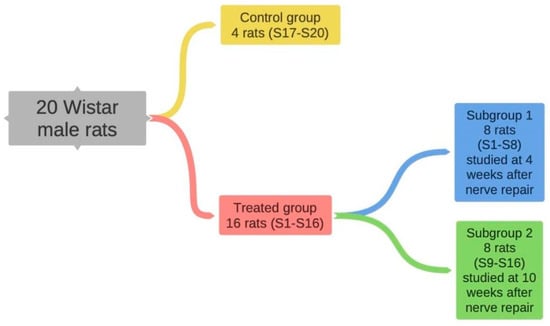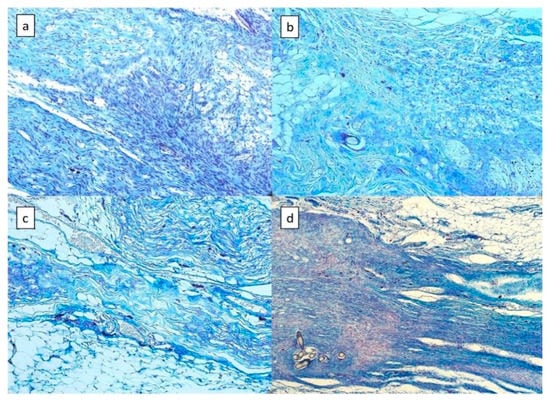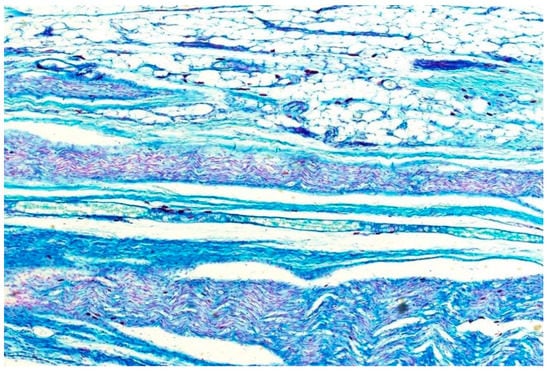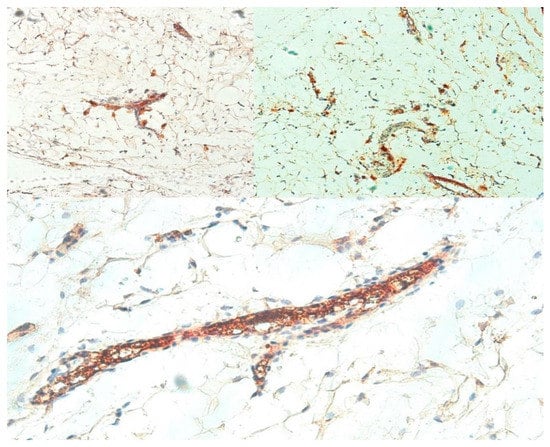Featured Application
Repair augmented with adipose-derived mast cells may improve outcomes for nerve injury.
Abstract
We aimed to analyze the involvement of adipose-sourced mast cells in nerve repair. Sixteen Wistar rats underwent complete transection of the sciatic nerves followed by either direct neurorrhaphy or neurorrhaphy and processed abdominal fat. Four animals were used as controls. Specimens were obtained at 4 and 10 weeks and analyzed using luxol fast blue stain, mast cell tryptase and CD34 (for angiogenesis) per microscopic field ×200. When assessed by luxol fast blue, normal nerves showed an average of 2–3 mast cells/field. At 4 weeks, there were 9.25 for the simple nerve sutures and 16 for the augmented repairs. At 10 weeks, there were 23 and 27.6. When assessed by mast cell tryptase, there were no positives in the controls. At 4 weeks, we found an average of 4 in the simple sutures and 2.5 in the augmented repairs. At 10 weeks, there were 4.5 and 0.2. In controls, there were 1–2 CD34+ blood vessels per field. At 4 weeks, simple repairs showed an average of 4 and, in those with adipose addition, 5.5. At 10 weeks, there were 7 and 12. Mechanically processed adipose tissue augmented nerve repair does not seem to increase mast cell expression but may support angiogenesis in an experimental model.
1. Introduction
Peripheral nerve injuries are common and pose a therapeutic challenge. More specifically, several medical and surgical therapeutic approaches have been suggested to re-establish nerve continuity with positive clinical results [1]. Augmented repair could offer improved outcomes and its potential benefits are currently being investigated [2]. Mast cells originate from hematopoietic progenitors and have terminal differentiation under local tissular environments [3]. They play key roles in inflammation modulation and tissue healing, but their role in nerve regeneration is not yet fully understood [1,2,3,4].
A recent study suggested that mast cells harvested from bone marrow could be involved in nerve injury repair, yet the authors could not specify which of the chemical mediators present in the cytoplasm have a more potent effect [5]. Immunohistochemically, mast cells are positive to tryptase but also to mast cell kinase, and there is a positive association between the increased mast cell subpopulation and vascular density (CD34+). The link between mast cells and nerves has been studied mostly in the enteric nervous system, the liver, the urinary bladder and the skin. The connection between mast cells and nerves can appear in both physiological and pathological conditions. Neuronal mechanisms are involved in mast cell activation and, in turn, mast cells activate local inflammatory processes. Therefore, an increase in mast cells can lead to the activation of chemical mediators and degranulation [6]. In the peripheral nervous system, the implication of mast cells is currently linked to autoimmune diseases. For example, it was shown that mast cells can produce nerve growth factor (NGF) and react to its presence in an autocrine fashion [7].
Autologous adipose-derived stem cells are currently used in many regenerative applications because they are easily harvested and are a suitable source of mesenchymal stem cells for therapy. In addition, they are considered supportive of axonal growth and may therefore aid with peripheral nerve repair [8]. Poglio et al. demonstrated that in mice, white adipose tissue stroma-vascular fraction contains precursors comparable to those found in bone marrow derivatives. These are able to become functional mast cells in peripheral organs such as the intestine and skin [9].
We aimed to analyze the potential involvement of adipose-sourced mast cells in nerve repair in an experimental animal model.
2. Materials and Methods
We used 20 Wistar male rats, weighing between 400 and 600 g, aged between 6 and 8 months. Sixteen animals formed the study group. Four rats (8 sciatic nerves) were used as reference for the normal sciatic nerve and gastrocnemius muscle—an indirect measure of nerve regeneration [10].
The study animals were operated on using continuous general anesthesia (Isoflurane, Fresenius Kabi, Bucharest, Romania) by the same surgeon. A complete transection of the sciatic nerve was performed on both hind limbs followed by:
- Direct neurorrhaphy (end-to-end nerve repair) alone on the right side;
- Neurorrhaphy plus processed fat autograft around the nerve on the left.
The 16 rats (treatment group) were analyzed at 2 time points:
- The first 8 animals (S1–S8) were sacrificed at 4 weeks after nerve repair;
- The following 8 at 8 weeks.
Animals were culled by injecting T61 (embutramide, Intervet/Schering-Plough Animal Health, NJ, USA). Nerve and gastrocnemius muscle biopsies were collected from both hind limbs (Figure 1). The authors used a similar model in a previous study [11].

Figure 1.
The control group and the two treatment arms.
Approximately 3 g of fat tissue was harvested from the inguinal area and centrifuged for 3 min at 3000 rpm (1008× g). This led to separation in three layers, from top to bottom: oil, processed fat, and the fluid portion. We used the processed fat to cover the nerve repair site on all left limbs.
The tissue specimens were fixed in 10% buffered formalin for 24 h, followed by routine paraffin embedding. Three micrometer serial sections were performed, and one slide for each case was stained with hematoxylin and eosin for histopathological diagnosis. One slide from each case was stained by luxol fast blue histochemical method, following the manufacturer’s instructions (Bio-Optica, Milano, Italy).
Additional slides were selected to quantify CD34-positive (Abbiotec, San Diego, CA, USA) blood vessel cells as a measure of angiogenesis, together with mast cell tryptase (MCT) (Leica Microsystems, Wetzlar, Germany). All immunohistochemical procedures were performed automatically using the Bond Max System (Leica Microsystems, Wetzlar, Germany).
On day 0, after anesthesia, we performed ultrasonography sizing of both (right and left) gastrocnemius muscles for each animal. The process was repeated at 4 weeks and 10 weeks. We recorded the maximum diameters (at their thickest part) using a Mindray M5 portable ultrasound with a linear piece 7L4S (Mindray, Shenzhen, China). Measurements were repeated 3 times during each session and a mean value of the diameter was used for each group, as previously described [10].
Conventional microscopy was performed for the interpretation of morphology and immunohistochemically stained slides by an AxioZoom Image A2 Research Microscope (Zeiss, Jena, Germany). Images were acquired by an AxioCam 506 Color and analyzed with ZEN software (Zeiss, Jena, Germany). Quantification method: select 3 consecutive microscopic fields with the highest number of mast cells and vascular density, count the number of blood vessels and mast cells at 20× magnification, and determine the mean value. Descriptive statistics are presented using Microsoft Excel (Microsoft, Washington, DC, USA).
3. Results
3.1. Mast Cells
3.1.1. Assessed by Luxol Fast Blue
Microscopic evaluation of the normal nerves—the control group showed a low density of mast cells in the nerve and the adjacent tissue. The mast cell density inside the nerve was on average 2–3/microscopic field ×200.
At 4 weeks, we found an average of 9.25 mast cells/microscopic field ×200 on the side with simple nerve suture, with one case showing 22 mast cells/microscopic field ×200. Repairs augmented with the adipose graft showed an average of 16 mast cells/microscopic field ×200 (Table 1, Figure 2). The total number of mast cells was obtained by considering both nerve tissue and adipose tissue.

Table 1.
The average number of mast cells (both luxol fast blue and tryptase positive) and CD34+ cells per microscopic field at ×200 magnification.

Figure 2.
Aspects at 4 and 10 weeks for the right (a,b) and left (c,d) sciatic nerves; in this example, there is a higher concentration of mast cells positive to luxol fast blue in the suture augmented with adipose tissue.
At 10 weeks, the number of mast cells increased both at the site of simple nerve suture and at the site of adipose augmentation. Simple neurorrhaphy cases had an average of 23 mast cells/microscopic field ×200. Neurorrhaphy plus adipose had an average of 27.6 total mast cells/microscopic field ×200: 16 from neural tissue and 11.6 from the adipose graft (Table 1, Figure 3).

Figure 3.
An example of sciatic nerve treated by neurorrhaphy at 10 weeks. The addition of adipose tissue yields a higher number of mast cells, inside the nerve and in the tissue surrounding it (luxol fast blue, magnification ×200).
3.1.2. Assessed by Mast Cell Tryptase
There were no mast cell tryptase positives in the normal nerves—control group per microscopic field ×200.
At 4 weeks, we found an average of 4 mast cell tryptase positives in the simple nerve sutures and 2.5 in the repairs augmented with an adipose graft. The total number of mast cells was obtained by considering both nerve tissue and adipose tissue.
At 10 weeks, we found an average of 4.5 mast cell tryptase positives at the site of simple nerve suture and 0.2 at the site of adipose augmentation (Table 1).
3.2. Angiogenesis
Angiogenesis was evaluated by determining CD34 expression. The number of blood vessels in the normal nerves (control group) was very low, approximately 1–2 blood vessels in the microscopic field ×200.
At 4 weeks, nerves treated only by suture showed an average of 4 blood vessels per microscopic field ×200, compared to 5.5 for those with suture and adipose additions (Table 1, Figure 4).

Figure 4.
Expression of CD34+ at 4 weeks in the grafted adipose tissue around the sutured nerve, (magnification ×200).
At 10 weeks, the average number of blood vessels was 7 per microscopic field ×200 for the simple nerve suture and 12 for those with adipose tissue addition, respectively.
3.3. Muscular Atrophy
The diameter of the gastrocnemius was measured by ultrasonography at the beginning of the study, at 4 weeks for the first group, and at 10 weeks for the second group. The average values are presented in Table 2.

Table 2.
Average diameters (cm) of the gastrocnemius muscle for each subgroup.
4. Discussion
In our study, rat sciatic neurorrhaphy augmented with a processed fat autograft led to less mast cells as determined by luxol fast blue and tryptase, compared to a simple end-to-end suture. There were more CD34+ blood vessels at 10 weeks and comparable ultrasonographic gastrocnemius muscle atrophy throughout.
The involvement of mast cells in the inflammatory process and in immune reactions is well studied, but their implication in central and peripheral nervous system repair was only recently discovered. The role of mast cells in nerve regeneration is supported by their heterogeneous, morphological and functional characteristics [12,13]. Post-traumatic nerve regeneration is a complex process which involves cellular interactions, growth factors, proteins and enzymes. These facts have been evaluated using an adult rat femoral nerve in a regeneration room type H [14]. Hong et al. support the idea of a link between chemotaxis after nerve injury and the benefits of using a regeneration room to improve the motor functions of the injured nerve [15]. Our study found that vascular density starts to increase from the second part of the regeneration process, between 4 and 10 weeks, with a decrease in the mast cell subpopulation within the neural tissue. It seems that adipose tissue addition inhibits the mast cell subpopulation positive to tryptase, avoiding the inflammatory process which can appear nearby. The angiogenesis process involved in nervous regeneration may be an early event. At both 4 and 10 weeks the morphology of the CD34 blood vessels—immature, intermediate, and mature—suggests an active and continuous angiogenesis process. The results of our present study suggest multiple methods of mast cell involvement in nervous regeneration. The CD34-positive cells with different morphologies than the endothelial cells may be Schwan cell progenitors, but further studies are needed.
Mast cells may stimulate CD34 fibroblastic cells from the adipose tissue, which could be involved in repairing either an injured nerve or the muscle innervated by it. The participation of mast cells in muscle regeneration has been previously described. Different research groups showed that mast cell tryptase is involved in repairing an injured muscle by stimulating myoblasts [15,16]. Regarding the tryptase mast cell subpopulation, we consider that they may have a limited effect on the angiogenesis process. It seems that adipose tissue addition has an anti-inflammatory effect, especially if we consider adipose tissue to be one of the sources of mast cells and of progenitor cells. The CD34 progenitor cells have been demonstrated to play a role in nerve repair, but not to such an intense degree as the vascular endothelial growth factor (VEGF) [17,18]. The presence of the CD34 progenitor cells in the injured nerve has been associated with an increase in the regenerative process [19]. On the other hand, the increase in the CD34 progenitor cells may be involved in the nervous regeneration process independent of the mast cells. Dayer et al. demonstrated that adipose tissue has an anti-inflammatory effect by containing IL-1, which, when associated with IL-10, can produce IFN Beta [20].
In addition to heparin, histamine, interleukins, and granules, mast cells also contain NGF (the nerve growth factor), which is involved in immune and inflammatory processes [21]. Therefore, mast cells should be able to produce both nerve injury as well as repair, via their numerous degranulation factors. These biochemical and molecular processes remain unclear so far. Together with other inflammatory cells, the mast cells express the CD300f receptor, well known for its involvement in nerve injury but also in nerve repair [22]. Similar to our study, Peluffo et al. have analyzed the accumulation of macrophages close to the injured sciatic nerve, but also the role of inflammatory mediators in injured nerve tissue [22]. The injured sciatic nerve repair process involves mast cells, macrophages, Schwann cell activation and myelin scrap removal. The interaction between all these factors was identified as a key event in the degenerative and healing processes of the central nervous system.
Hsu et al. have proven the involvement of stem cells from the adipose tissue in nervous regeneration [23]. The BRCA1 gene, involved in ovarian and breast cancers, represents a regulator factor for the integrity of neurons and glial cells [24]. Via chemical mediators, mast cells could be involved in nervous stem cell activation. Different development levels of the nervous system depend on cell location, which could also interfere with the repairing process [25].
Limitations of our study: The low number of specimens and relatively broad range of individual values and small differences between average results made any statistical comparison unreliable. The presented images do not depict immunohistochemistry or immunofluorescence studies to make the mast cells around nerves more evident. We did not test for inflammatory markers specific to adipose tissue, nor any additional mediators such as CD31 or VEGF to help discriminate between angiogenesis and stromal vascular fraction present in the adipose tissue. We did not identify cell subpopulations by flow cytometry, cell sorting, or staining of fatty areas.
Ultimately, we aimed to showcase the implications of mast cells and other inflammatory cells in nerve regeneration. Mast cells combined with adipose tissue could, in future, be a novel treatment in the recovery of the motor neural function. Peripheral nerve injuries result in life changing conditions for patients as well as present a social and economic burden. Current nerve injury treatments include direct nerve repair (end-to-end suture), autologous nerve graft, and surgical nerve transfer. Despite recent advancements, there is a high demand for novel procedures which could bring improved functional recovery. Cell-based therapies in nerve regeneration are highly promising [16].
5. Conclusions
Mechanically processed adipose tissue augmented peripheral nerve suture repair does not seem to increase mast cell expression but may support angiogenesis in an experimental rat model.
Author Contributions
Conceptualization, V.B., T.B. and Z.C.; methodology, A.C.; software, A.-M.C.; validation, V.B., A.C. and T.B.; formal analysis, V.B.; investigation, A.C.; resources, A.C.; data curation, A.-M.C.; writing—original draft preparation, V.B.; writing—review and editing, H.H.; visualization, Z.C.; supervision, T.B.; project administration, V.B.; funding acquisition, V.B. and H.H. All authors have read and agreed to the published version of the manuscript.
Funding
The APC was funded by the University of Medicine and Pharmacy ‘Victor babes’ Timisoara.
Institutional Review Board Statement
The study was conducted according to the guidelines of the Declaration of Helsinki and approved by the Institutional Review Board (or Ethics Committee) of Emergency Clinical County Hospital ‘Pius Brinzeu’ (protocol code 45/17 May 2019).
Informed Consent Statement
Not applicable.
Conflicts of Interest
The authors declare no conflict of interest.
References
- Roccuzzo, A.; Molinero-Mourelle, P.; Ferrillo, M.; Cobo-Vázquez, C.; Sanchez-Labrador, L.; Ammendolia, A.; Migliario, M.; de Sire, A. Type I Collagen-Based Devices to Treat Nerve Injuries after Oral Surgery Procedures. A Systematic Review. Appl. Sci. 2021, 11, 3927. [Google Scholar] [CrossRef]
- Jones, S.; Eisenberg, H.M.; Jia, X. Advances and Future Applications of Augmented Peripheral Nerve Regeneration. Int. J. Mol. Sci. 2016, 17, 1494. [Google Scholar] [CrossRef] [PubMed]
- Akula, S.; Paivandy, A.; Fu, Z.; Thorpe, M.; Pejler, G.; Hellman, L. Quantitative In-Depth Analysis of the Mouse Mast Cell Transcriptome Reveals Organ-Specific Mast Cell Heterogeneity. Cells 2020, 9, 211. [Google Scholar] [CrossRef] [PubMed]
- Tanaka, S. Phenotypic and Functional Diversity of Mast Cells. Int. J. Mol. Sci. 2020, 21, 3835. [Google Scholar] [CrossRef] [PubMed]
- Ilkhanizadeh, B.; Zarei, L.; Farhad, N.; Bahrami-Bukani, M.; Mohammadi, R. Mast cells improve functional recovery of transected peripheral nerve: A novel preliminary study. Injury 2017, 48, 1480–1485. [Google Scholar] [CrossRef] [PubMed]
- Kleij, H.P.; Bienenstock, J. Significance of Conversation between Mast Cells and Nerves. Allergy Asthma Clin. Immunol. 2005, 1, 65–80. [Google Scholar] [CrossRef] [PubMed]
- Skaper, S.D. Nerve growth factor: A neuroimmune crosstalk mediator for all seasons. Immunology 2017, 151, 1–15. [Google Scholar] [CrossRef]
- Lavorato, A.; Raimondo, S.; Boido, M.; Muratori, L.; Durante, G.; Cofano, F.; Vincitorio, F.; Petrone, S.; Titolo, P.; Tartara, F.; et al. Mesenchymal Stem Cell Treatment Perspectives in Peripheral Nerve Regeneration: Systematic Review. Int. J. Mol. Sci. 2021, 22, 572. [Google Scholar] [CrossRef] [PubMed]
- Poglio, S.; De Toni-Costes, F.; Arnaud, E.; Laharrague, P.; Espinosa, E.; Casteilla, L.; Cousin, B. Adipose tissue as a dedicated reservoir of functional mast cell progenitors. Stem Cells 2010, 28, 2065–2072. [Google Scholar] [CrossRef]
- Hundepool, C.A.; Nijhuis, T.H.J.; Rbia, N.; Bulstra, L.F.; Selles, R.W.; Hovius, S.E.R. Noninvasive Ultrasound of the Tibial Muscle for Longitudinal Analysis of Nerve Regeneration in Rats. Plast. Reconstr. Surg. 2015, 136, 633e–639e. [Google Scholar] [CrossRef] [PubMed]
- Bloancă, V.; Ceauşu, A.R.; Jitariu, A.A.; Barmayoun, A.; Moş, R.; Crăiniceanu, Z.; Bratu, T. Adipose Tissue Graft Improves Early but not Late Stages of Nerve Regeneration. In Vivo 2017, 31, 649–655. [Google Scholar] [CrossRef] [PubMed][Green Version]
- Alim, M.A.; Peterson, M.; Pejler, G. Do Mast Cells Have a Role in Tendon Healing and Inflammation? Cells 2020, 9, 1134. [Google Scholar] [CrossRef] [PubMed]
- Stevens, R.L.; Adachi, R. Protease-proteoglycan complexes of mouse and human mast cells and importance of their beta-tryptase heparin complexes in inflammation and innate immunity. Immunol. Rev. 2007, 217, 155–167. [Google Scholar] [CrossRef] [PubMed]
- Hong, X.Y.; Hong, X.; Gu, W.W.; Lin, J.; Yin, W.T. Femoral nerve repair using an h-type nerve regeneration chamber in rats. J. Biol. Regul. Homeost. Agents 2017, 31, 335–341. [Google Scholar] [PubMed]
- Duchesne, E.; Bouchard, P.; Roussel, M.P.; Cote, C.H. Mast cells can regulate skeletal muscle cell proliferation by multiple mechanisms. Muscle Nerve 2013, 48, 403–414. [Google Scholar] [CrossRef] [PubMed]
- Yamamoto, D.; Tada, K.; Suganuma, S.; Hayashi, K.; Nakajima, T.; Nakada, M.; Matsuta, M.; Tsuchiya, H. Differentiated adipose-derived stem cells promote peripheral nerve regeneration. Muscle Nerve 2020, 62, 119–127. [Google Scholar] [CrossRef]
- Eren, F.; Öksüz, S.; Küçükodaci, Z.; Kendırlı, M.T.; Cesur, C.; Alarçın, E.; Irem Bektaş, E.; Karagoz, H.; Kerımoğlu, O.; Köse, G.T.; et al. Targeted mesenchymal stem cell and vascular endothelial growth factor strategies for repair of nerve defects with nerve tissue implanted autogenous vein graft conduits. Microsurgery 2016, 36, 578–585. [Google Scholar] [CrossRef] [PubMed]
- Trocan, I.; Ceausu, R.; Jitariu, A.; Haragus, H.; Damian, G.; Raica, M. Healing potential of the anterior cruciate ligament remnant stump. In Vivo 2016, 30, 225–230. [Google Scholar]
- Sheu, M.L.; Cheng, F.C.; Su, H.L.; Chen, Y.J.; Chen, C.J.; Chiang, C.M.; Chiu, W.-T.; Sheehan, J.; Pan, H.-C. Recruitment by SDF-1α of CD34-positive cells involved in sciatic nerve regeneration. J. Neurosurg. 2012, 116, 432–444. [Google Scholar] [CrossRef]
- Dayer, J.M.; Chicheportiche, R.; Juge-Aubry, C.; Meier, C. Adipose tissue has anti-inflammatory properties: Focus on IL-1 receptor antagonist (IL-1Ra). Ann. N. Y. Acad. Sci. 2006, 1069, 444–453. [Google Scholar] [CrossRef] [PubMed]
- Hackelberg, S.; Tuck, S.J.; He, L.; Rastogi, A.; White, C.; Liu, L.; Prieskorn, D.M.; Miller, R.J.; Chan, C.; Loomis, B.; et al. Nanofibrous scaffolds for the guidance of stem cell-derived neurons for auditory nerve regeneration. PLoS ONE 2017, 12, e0180427. [Google Scholar] [CrossRef] [PubMed]
- Peluffo, H.; Solari-Saquieres, P.; Negro-Demontel, M.L.; Francos-Quijorna, I.; Navarro, X.; Lopez-Vales, R.; Sayos, J.; Lago, N. CD300f immunoreceptor contributes to peripheral nerve regeneration by the modulation of macrophage inflammatory phenotype. J. Neuroinflamm. 2015, 12, 145. [Google Scholar] [CrossRef]
- Hsu, M.N.; Liao, H.T.; Li, K.C.; Chen, H.H.; Yen, T.C.; Makarevich, P.; Parfyonova, Y.; Hu, Y.C. Adipose-derived stem cell sheets functionalized by hybrid baculovirus for prolonged GDNF expression and improved nerve regeneration. Biomaterials 2017, 140, 189–200. [Google Scholar] [CrossRef] [PubMed]
- Krishnan, A.; Purdy, K.; Chandrasekhar, A.; Martinez, J.; Cheng, C.; Zochodne, D.W. A BRCA1-Dependent DNA Damage Response in the Regenerating Adult Peripheral Nerve Milieu. Mol. Neurobiol. 2018, 55, 4051–4067. [Google Scholar] [CrossRef] [PubMed]
- Marcus, M.; Baranes, K.; Park, M.; Choi, I.S.; Kang, K.; Shefi, O. Interactions of Neurons with Physical Environments. Adv. Healthc. Mater. 2017, 6, 1700267. [Google Scholar] [CrossRef] [PubMed]
Publisher’s Note: MDPI stays neutral with regard to jurisdictional claims in published maps and institutional affiliations. |
© 2021 by the authors. Licensee MDPI, Basel, Switzerland. This article is an open access article distributed under the terms and conditions of the Creative Commons Attribution (CC BY) license (https://creativecommons.org/licenses/by/4.0/).